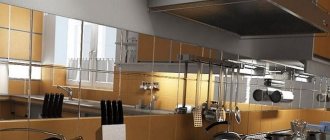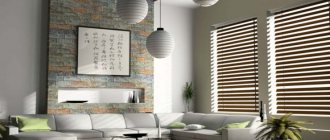Ceramic tiles - the choice of many generations
Modern methods of cladding various surfaces are extremely diverse. The place that tiles occupy among wall and floor coverings is deserved by many years of testing their high performance characteristics.
Already in ancient times, the advantages of tiled tiles were known firsthand, but were available only to the wealthy class. Such luxury as ordinary floor tiles for the kitchen and corridor a hundred or two hundred years ago was an indicator of the prosperity of the owners of the house.
In the 21st century, tiling surfaces has become available to customers with any income level. Thanks to high competition, the technological characteristics of finishing materials are constantly improving, and prices are becoming lower after the next update of the range.
When choosing tiles for the kitchen floor, a prudent owner will consider not only the options offered at the nearest hardware store, but will also analyze all the offers available on the market.
Types of floor tiles
Tiles can be wall, floor and facade. These three types of products differ in their technical characteristics. The thinnest are wall tiles, the most durable are tiles that cover the external walls of buildings. For example, all types of outdoor tiles almost do not absorb water, are heat and frost resistant, and have the properties necessary for many years of outdoor service.
Minimum requirements apply to the durability of wall tiles used in the bathroom and kitchen. It can be quite thin, but this should be kept in mind and not expose the ceramic to excess.
In terms of their strength and thickness, floor tiles are the optimal middle option between façade and wall tiles.
Pros and cons of ceramic tiles
Where food is prepared, dirt collects on the floor much faster than in other areas. The only thing that can compete with the rate of contamination of the kitchen floor is the hallway hallway.
It is quite understandable why homeowners first choose the design of floor tiles for the kitchen, often leaving other characteristics of the facing materials without attention.
Note!
Epoxy grout for tiles: pros and cons, scope, varieties, how to work with it (instructions + photos)
- Do-it-yourself tile shower tray step by step: instructions, dimensions, design, installation of communications, types of structures, photos
White tiles in the bathroom: 170 photos of the best ideas and new tile designs. Layout schemes and beautiful combinations
Both low soiling and the combination of tiles with other components of the interior are certainly important, but from a practical point of view, you should first decide not on the design or size of the ceramic elements, but on its functional properties.
Why do many people choose tiles rather than laminate or other floor coverings:
- the tile does not absorb water and dirt and is easy to clean;
- resistant to abrasion, deformation, exposure to ultraviolet radiation, chemical reagents, non-flammable;
- there are many options for its execution: for example, wood floor tiles (most likely it will be porcelain stoneware) do not differ in appearance from real wooden floors.
There are not many disadvantages to tiles as a floor covering. These include the relatively high cost of some types of this material, as well as professional work on preparing a heated floor for the kitchen under the tiles (if you don’t want to constantly wear slippers in the kitchen and hallway).
Composite Vinyl Panel
Composite Vinyl Panel
This is an extension of the previous two concepts. This panel is made up of multiple layers bonded together, including layers of composite material that make it such an extraordinary panel.
Thanks to its structure, we have a finished product that, due to its greater thickness, is resistant to substrate unevenness and better dampens sounds.
Types of wear-resistant tiles
Porcelain tiles or ordinary floor tiles? Mosaic, square or rhombic? Seamed or seamless, wide format or standard size? When figuring out which tile is better for the kitchen floor, you should know that the tiles vary:
- By manufacturing method:
- pressed (a special mixture is pressed, then fired in an autoclave for firing, laid using the joint method, requires grouting the joints after laying on the surface);
- extruded (the same material is extruded through a special mold and also processed in an autoclave, but the finished product is laid using a seamless method);
- porcelain stoneware (very different in composition, but made using the above-mentioned pressed tile method).
- glazed tiles (a glass-like glossy coating that can be painted on);
- unglazed tiles (the color of the tiles is always from the range of red-terracotta undertones, or is determined by the pigment added to the initial mixture for firing). This type of tile is frost-resistant and has high adhesion, so it is often used on steps, terraces and streets. However, it is more difficult to clean from dirt;
- porcelain stoneware - in appearance it is similar to ordinary granite, therefore it is often used in solutions for premises that require a note of monumentality and emphasized financial well-being of the owners.
Laying methods
When the color and shape of the tiles are chosen, installation of the product begins. Here everyone decides for themselves whether to trust the master or start styling with their own hands. The methods differ according to the type of masonry:
- Traditional. The figures line up corner to corner. This method is suitable for single-color tiles or a checkerboard layout.
- Bias. It will help you create an original floor design from a modest and discreet base.
- Diagonally. A modern solution for a small kitchen space. Thanks to this method, you can visually lengthen the room.
- Imitation of parquet pattern. It is difficult to perform this installation option without experience and skills.
- Modular grid. The tiles are laid in a special pattern, which is difficult for a beginner to imagine and design; it is better to entrust the work to a master.
- Christmas tree with attachment. Not suitable for material with a catchy design or pattern. Using small inserts, a composition with bright splashes is created.
Expert opinion
Olga Kovalenko
Since 2010 I have been engaged in interior design and architectural design.
The size of the tiles should be a multiple of the width and length of the room, so that there is as little trimming of solid products as possible.
Sizes and shapes of floor tiles
The choice of any type of finishing materials depends on the expected intensity of their use, the type of room and other parameters.
Professionals select the shape and size of floor tiles in accordance with the final purpose of use - tiles, which have an unusual shape and high wear resistance, allow the implementation of many original design solutions. Multifaceted, mosaic or rounded kitchen floor tiles are a fairly popular solution in modern interiors.
Note!
- Italian tiles for floors and walls: photos of beautiful tile designs in the bathroom and kitchen. Choosing tile color, style and size
Marble tiles for the bathroom: TOP-200 photos of original design, ideas for mixing and matching
- Do-it-yourself tile shower step by step: instructions, algorithm of actions, dimensions, layout diagrams, photo of a shower with and without a tray
Today, ceramic cladding materials are available on the market in a variety of sizes. Before the actual laying of tiles on the kitchen floor begins, you should make an accurate measurement of the area of the room, simulating the matching of the tile pattern.
If it is not possible to take the advice of an experienced craftsman, you should find special online calculators on the Internet and calculate the tiles for the floor, remembering that if there is not enough quantity, it may be difficult to purchase more, and in any case it will not hurt to have spare tiles on hand.
If the size of the solid elements does not coincide exactly with the area of the room, then some of them can be given a suitable shape using professional cutting.
Resistance to aggressive detergents
To determine the tile’s resistance to aggressive cleaning agents, you need to look for a bulb-shaped icon on the packaging.
The marking “A” or “AA” next to the flask indicates that the material can be washed using chemicals.
Beauty and functionality
Wherever kitchen floor tiles are sold - in Leroy Merlin or in any other hardware store, you should not only listen to the sales consultant, but also clearly understand what kind of final result is desired upon completion of the finishing work. To do this, you need to familiarize yourself in advance with the range and properties of goods offered on the market.
Having seen a photo of kitchen floor tiles that fit perfectly into the intended design project, you should not rush to order it. First you need to check the main technical characteristics inherent in the selected material and the manufacturer’s guarantee for the long-term preservation of the appearance of the product and its functional properties.
Note!
Mosaic from broken tiles: step-by-step instructions on how to lay it out with your own hands (140 photo ideas)
Mosaic for the bathroom: TOP-150 photos of new designs, as well as modern ideas for combining mosaic tiles
- Do-it-yourself water heated floor under tiles step by step: installation instructions with photos and descriptions, installation and connection
Any ceramic floor tiles for the kitchen should continue to be suitable for use if:
- a caustic liquid spilled on the floor, boiling water spilled, a heavy hot household item fell;
- there are sudden temperature changes in the room;
- There is constantly high humidity in the room;
- tiles are regularly exposed to physical impact (moving furniture, interacting with objects that scratch its outer layer).
It is precisely because wall tiles do not meet the last criterion that they cannot be laid on the floor, while on the contrary - as much as you like.
Linoleum
A traditional vinyl floor covering that is inexpensive and quick to install. Linoleum is sold in rolls of various widths. It differs not only in texture and patterns, but also in the number of layers and the type of bottom layer.
It is worth noting that all types of vinyl floor coverings differ in wear resistance class. It is not uncommon for linoleum sellers to ignore this characteristic parameter, but it exists. True, it is not particularly important for apartments, due to low traffic.
The main criteria for choosing tiles for the kitchen
So, the product must meet the following requirements:
- wear resistance (5 levels of strength);
- frost resistance (indicates the minimum temperature at which the ceramics will not crack);
- water absorption (the figure should not exceed 3%);
- resistance to mechanical and chemical stress (5 strength classes - from AA to D, where AA is the most reliable);
- fire resistance (indicates the maximum temperature at which the ceramics will not begin to melt);
- suitable coefficient of friction (from 0 to 0.75, the latter is considered the safest).
Tile base
Regular floor tiles or porcelain tiles? Everyone decides for themselves according to their needs and financial capabilities.
In addition, the owner of the renovated kitchen will have to decide what the base for the kitchen floor will be under the tiles and how much he is willing to pay for it.
There are many options:
- drywall is a fairly durable and inexpensive material that does not require special leveling;
- plywood - careful processing is required to increase the moisture resistance of the base. However, there is special plywood for outdoor use and so-called bakelite plywood, which is used in aircraft and shipbuilding;
- plaster - with its help the concrete base is leveled, but permissible unevenness should not exceed 3 mm;
- old tiles - they must be covered with a special primer and the loose tiles must be dismantled before doing this.
The ceramic tile itself is attached to the base using an appropriate elastic adhesive that is able to adhere to smooth and non-absorbent surfaces.
Direct laying of ceramic tiles on aerated concrete, foam concrete, as well as wood chipboards and oriented strand boards is prohibited.
Variety of shapes and colors
Having decided on the quality of the product, you can proceed to the most enjoyable part of the process - choosing a color scheme.
In Russia, since the end of perestroika, more and more new companies producing ceramic tiles began to appear - both private ones offering handmade products for individual orders, and representatives of foreign companies with many years of experience. Everyone has been hearing about Kerama Marazzi tiles for many years, which in the early 1990s showed citizens of the former USSR that the number of decorative solutions for facing materials tends to infinity, and the range can be completely updated every new season.
The choice is huge and it’s unlikely that any harsh advice is appropriate here.
Many owners prefer the classics - and this, of course, is white tiles in the kitchen, on the floor of which, however, any crumb or pet hair will be instantly noticeable. However, housewives who keep the kitchen as clean as an operating room choose this particular floor color.
A marble-like floor tile, which has graceful veining and matches most kitchen interiors, will hide an untimely speck much better. Gray tiles for the kitchen floor are very practical - they are most suitable for temporarily hiding minor dirt that is inevitable during cooking.
But the main decision that the buyer of this type of ceramic products has to make is, oddly enough, not the quality, shape or color, but whether the heated floor in the kitchen will be prepared for tiles, or whether the base will remain unchanged.
Which grout should I choose?
The primary function of grout is protection against moisture, dirt and mold. But in some cases it can also play a decorative role - for example, in the case when a contrasting dark gray grout is chosen for white tiles, which effectively highlights the shape of the product and the method of installation.
When choosing grout, you should adhere to the following rules:
- Grouting to match the tile is the most versatile option, allowing you to create a single, visually continuous surface.
To understand how ideally the grout matches the shade of the tile, it is best to apply a small amount of the solution to the surface of the tile in the store before purchasing, wait until it dries and evaluate the result.
- Choose a contrasting grout if the floor tiles in the kitchen are monochromatic or serve as the main accent.
- White and black grout quickly loses its neat and tidy appearance, so it is not advisable to use it.
- For multi-colored tiles, clear grout or the color that predominates in the flooring design is best.
The compatibility of the shade of the floor covering and the grout can be determined from the table below.
Warm floor under tiles in the kitchen
Heating elements for underfloor heating in an apartment building can only be electric, while in a private house you can also use a so-called water circuit that does not take water from the general heating system used in high-rise buildings.
Installation of floor heating systems is carried out not only in rooms with ceramic flooring, but also where laminate flooring is installed. But ordinary wooden floors, as a rule, do not need such heating.
The thermal conductivity of ceramic flooring is very high, so this kind of home upgrade will be appreciated by both owners and guests.
The reasons why underfloor heating cannot be installed can be both financial and domestic. In this case, you should choose floor tiles with high adhesive properties and be sure to buy cozy slippers for the winter. Slippers are relatively inexpensive, and the beauty and benefits of tiles are certainly priceless.











